中西方文化的不同 中英文对照
- 格式:ppt
- 大小:2.29 MB
- 文档页数:25

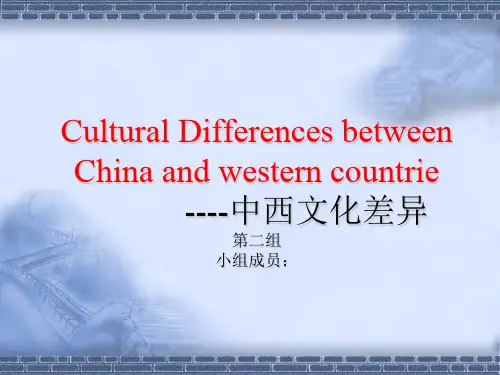

英汉的文化差异及翻译外国文学最难了解和翻译的第一是联想的意义,接下来,小编给大家准备了英汉的文化差异及翻译,欢迎大家参考与借鉴。
英汉的文化差异及翻译一、英汉习语中所反映的文化差异朱光潜先生在《谈翻译》一文中说:"外国文学最难了解和翻译的第一是联想的意义……","它带有特殊的情感氛围,甚深广而微妙,在字典中无从找出,对文学却极要紧。
如果我们不熟悉一国的人情风俗和文化历史背景,对于文字的这种意义就茫然,尤其是在翻译时这种字义最不易应付。
"英国文化人类学家爱德华·泰勒在《原始文化》(1871)一书中,首次把文化作为一个概念提了出来,并表述为:"文化是一种复杂,它包括知识、信仰、艺术、道德、法律、风俗以及其作社会上习得的能力与习惯。
"可见文化的覆盖面很广,它是一个复要的系统。
语言作为文化的一个组成部分,反映一个民族丰富多彩的方化现象。
1、生存环境的差异习语的产生与人们的劳动和生活密切相关。
英国是一个岛国,历史上航海业曾一度领先世界;而汉民族在亚洲大陆生活繁衍,人们的生活离不开土地。
比喻花钱浪费,大手大脚,英语是spend money like water,而汉语是"挥金如土"。
英语中有许多关于船和水的习语,在汉语中没有完全相同的对应习语,如to rest on one's oars(暂时歇一歇),to keep one's head above water(奋力图存),all at sea(不知所措)等等。
在汉语的文化氛围中,"东风"即是"春天的风",夏天常与酷署炎热联系在一起,"赤日炎炎似火烧"、"骄阳似火"是常被用来描述夏天的词语。
而英国地处西半球,北温带,海洋性气候,报告春天消息的却是西风,英国著名诗人雪莱的《西风颂》正是对春的讴歌。
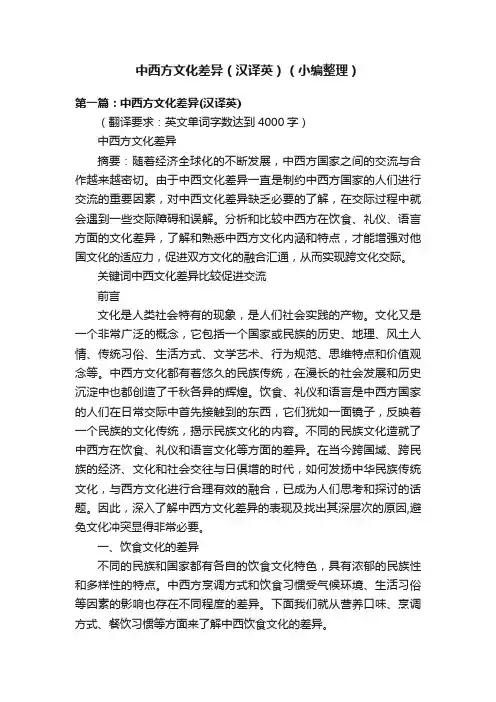
中西方文化差异(汉译英)(小编整理)第一篇:中西方文化差异(汉译英)(翻译要求:英文单词字数达到4000字)中西方文化差异摘要:随着经济全球化的不断发展,中西方国家之间的交流与合作越来越密切。
由于中西文化差异一直是制约中西方国家的人们进行交流的重要因素,对中西文化差异缺乏必要的了解,在交际过程中就会遇到一些交际障碍和误解。
分析和比较中西方在饮食、礼仪、语言方面的文化差异,了解和熟悉中西方文化内涵和特点,才能增强对他国文化的适应力,促进双方文化的融合汇通,从而实现跨文化交际。
关键词中西文化差异比较促进交流前言文化是人类社会特有的现象,是人们社会实践的产物。
文化又是一个非常广泛的概念,它包括一个国家或民族的历史、地理、风土人情、传统习俗、生活方式、文学艺术、行为规范、思维特点和价值观念等。
中西方文化都有着悠久的民族传统,在漫长的社会发展和历史沉淀中也都创造了千秋各异的辉煌。
饮食、礼仪和语言是中西方国家的人们在日常交际中首先接触到的东西,它们犹如一面镜子,反映着一个民族的文化传统,揭示民族文化的内容。
不同的民族文化造就了中西方在饮食、礼仪和语言文化等方面的差异。
在当今跨国域、跨民族的经济、文化和社会交往与日俱增的时代,如何发扬中华民族传统文化,与西方文化进行合理有效的融合,已成为人们思考和探讨的话题。
因此,深入了解中西方文化差异的表现及找出其深层次的原因,避免文化冲突显得非常必要。
一、饮食文化的差异不同的民族和国家都有各自的饮食文化特色,具有浓郁的民族性和多样性的特点。
中西方烹调方式和饮食习惯受气候环境、生活习俗等因素的影响也存在不同程度的差异。
下面我们就从营养口味、烹调方式、餐饮习惯等方面来了解中西饮食文化的差异。
(一)营养口味的差异。
西方饮食是一种理性观念,烹调讲究营养而忽视味道。
他们生吃西红柿、青瓜、生菜,甚至是洋白菜、西兰花等蔬菜,认为蔬菜只有生吃才能保证它原有的营养和原有的味道,而生炒煎煮会破坏蔬菜的维生素。
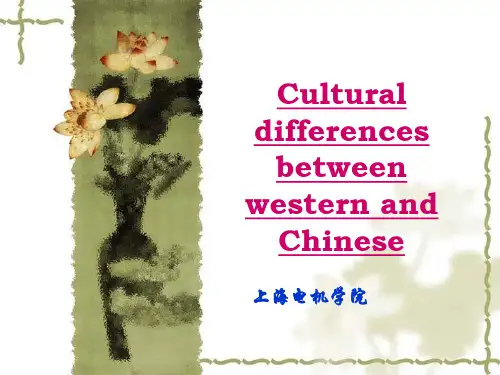
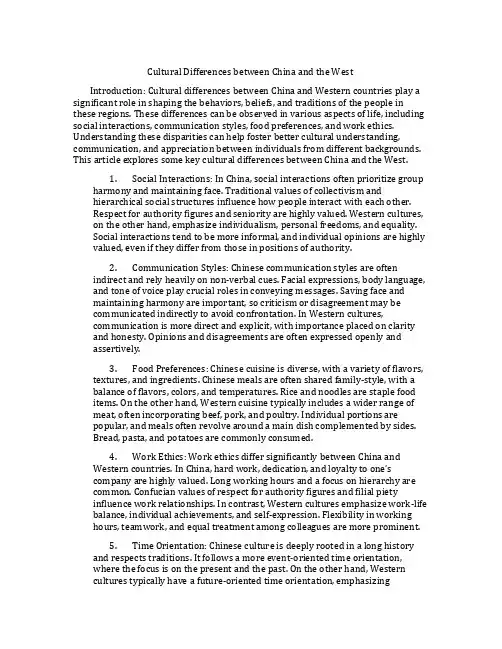
Cultural Differences between China and the WestIntroduction: Cultural differences between China and Western countries play a significant role in shaping the behaviors, beliefs, and traditions of the people in these regions. These differences can be observed in various aspects of life, including social interactions, communication styles, food preferences, and work ethics. Understanding these disparities can help foster better cultural understanding, communication, and appreciation between individuals from different backgrounds. This article explores some key cultural differences between China and the West.1.Social Interactions: In China, social interactions often prioritize groupharmony and maintaining face. Traditional values of collectivism andhierarchical social structures influence how people interact with each other.Respect for authority figures and seniority are highly valued. Western cultures, on the other hand, emphasize individualism, personal freedoms, and equality.Social interactions tend to be more informal, and individual opinions are highly valued, even if they differ from those in positions of authority.munication Styles: Chinese communication styles are oftenindirect and rely heavily on non-verbal cues. Facial expressions, body language, and tone of voice play crucial roles in conveying messages. Saving face andmaintaining harmony are important, so criticism or disagreement may becommunicated indirectly to avoid confrontation. In Western cultures,communication is more direct and explicit, with importance placed on clarity and honesty. Opinions and disagreements are often expressed openly andassertively.3.Food Preferences: Chinese cuisine is diverse, with a variety of flavors,textures, and ingredients. Chinese meals are often shared family-style, with a balance of flavors, colors, and temperatures. Rice and noodles are staple food items. On the other hand, Western cuisine typically includes a wider range of meat, often incorporating beef, pork, and poultry. Individual portions arepopular, and meals often revolve around a main dish complemented by sides.Bread, pasta, and potatoes are commonly consumed.4.Work Ethics: Work ethics differ significantly between China andWestern countries. In China, hard work, dedication, and loyalty to one’scompany are highly valued. Long working hours and a focus on hierarchy are common. Confucian values of respect for authority figures and filial pietyinfluence work relationships. In contrast, Western cultures emphasize work-life balance, individual achievements, and self-expression. Flexibility in working hours, teamwork, and equal treatment among colleagues are more prominent.5.Time Orientation: Chinese culture is deeply rooted in a long historyand respects traditions. It follows a more event-oriented time orientation,where the focus is on the present and the past. On the other hand, Westerncultures typically have a future-oriented time orientation, emphasizingplanning, progress, and achieving goals. Time is seen as a valuable resource to be managed efficiently.Conclusion: Cultural differences between China and the West manifest in various aspects of life, including social interactions, communication styles, food preferences, work ethics, and time orientation. Recognizing and appreciating these disparities can help individuals from different backgrounds develop better cross-cultural understanding and collaboration. By fostering cultural sensitivity and embracing diversity, we can build bridges between cultures and promote harmony in an increasingly interconnected world.。
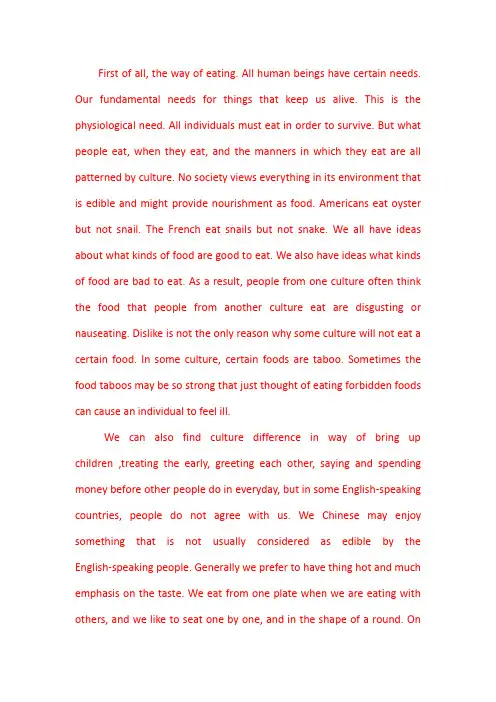
First of all, the way of eating. All human beings have certain needs. Our fundamental needs for things that keep us alive. This is the physiological need. All individuals must eat in order to survive. But what people eat, when they eat, and the manners in which they eat are all patterned by culture. No society views everything in its environment that is edible and might provide nourishment as food. Americans eat oyster but not snail. The French eat snails but not snake. We all have ideas about what kinds of food are good to eat. We also have ideas what kinds of food are bad to eat. As a result, people from one culture often think the food that people from another culture eat are disgusting or nauseating. Dislike is not the only reason why some culture will not eat a certain food. In some culture, certain foods are taboo. Sometimes the food taboos may be so strong that just thought of eating forbidden foods can cause an individual to feel ill.We can also find culture difference in way of bring up children ,treating the early, greeting each other, saying and spending money before other people do in everyday, but in some English-speaking countries, people do not agree with us. We Chinese may enjoy something that is not usually considered as edible by the English-speaking people. Generally we prefer to have thing hot and much emphasis on the taste. We eat from one plate when we are eating with others, and we like to seat one by one, and in the shape of a round. Onthe opposite, some English-speaking countries, most of the people like to seat in two rows, two people face to face. They have their own plate. On the aspect of table manners, there are many differences between Chinese and English-speaking people. For example, in some English-speaking countries, Bread plates are to the left of the main plate, beverage glasses are to the right. Salad fork, knife and soup spoon are far from the main plate than the main course knife, fork and spoon. When eating bread rolls, break off a piece before buttering. Use the knife only to butter the bread, not cut it. You should not start eating before your host does or instructs to do so. At large meals, it is considered okay to start eating once others have been served. When finished, place the knife and fork together at five o’clock with the fork on the left. It is considered rude to answer the telephone at the table. If need to take an urgent call, excuse self and go outside. Try to eat all the food you are served. But in China, the table manners are different. Chinese traditionally eat rice from a small bowl held in the left hand. The rice bowl is raised to the mouth and rice pushed into the mouth using the chopsticks. Some Chinese find it offensive to scoop rice from the bowl using a spoon. if rice is served on a plate, as is more common in the West, it is acceptable and more practical to eat it with a fork or spoon. The thumb must always be above the edge of the bowl. The host should always make sure the guest drinks are sufficiently full.One should notpour for oneself, but should offer to pour for a neighborhood. When your drink is being poured, you should say “thank you” and tap fingers on the table to show appreciation. When people wish to clink drinks together in the form of a cheer, it is important to observe that younger members should clink the edge of their drink below the edge of an elder to show respect.Secondly, the way of communication. Form birth to death, communication plays an integral part in our life.There are some language problems, including the different styles of using language such as direct, indirect; expansive, succinct; argumentative, conciliatory; instrumental, harmonizing; and so on. These different styles can lead to wrong interpretations of intent and evaluation of insincerity, aggressiveness, deviousness, or arrogance, among other.The misinterpretation includes nonverbal signs and symbols such as gestures, postures, and other body movements. It is a definite communication barrier. But it is possible to learn the meanings of these observable message, usually in informal rather ways.It is more difficult to understand the less obvious unspoken codes of the other cultures. Language, as the carrier of culture, is created during the process of human beings’ productive labor and serves as the tool of communication to convey the message between people. However, it has been endowed with magic and power in particular language acts.As the old saying goes,troubles come out of the tongue. Superstitious people think that the language itself can bring about fortune or misfortune so that taboos to restrict the use of language are created. Anyone who violates them will get punishment, whereas those who faithfully obey the restrictions of language taboo will get protection. Furthermore, linguistic taboos change with the development of society.The paper firstly analyzes the evolution of linguistic taboo. It is indicated in the paper that linguistic taboo exists in almost every aspect of people’s life and is a universal social phenomenon in China and Britain.Both Chinese and English cultures are in agreement about linguistic taboos such as pronunciation taboo, and vocabulary taboo. However, influenced by different cultural backgrounds, ideologies and the concepts of value, Chinese and English linguistic taboos also have differences, as is discussed in the paper from the aspects of taboo subjects, taboo numbers and names.At last, this paper puts forward two effective ways of avoid taboo, that is,using euphemism and having a good knowledge of the taboo culture. And this discussion would help English learners, improve their ability of cross-cultural communication and achieve better communicational effects. For example, during the feudal times, people were not equal to the rulers and were suppressed by their superiors.The distinction between the upper and the lower classes was also reflected in the evaluation of the language used by them respectively. The words ofupper class used were considered good and elegant while those used by the lower class were regarded as vulgar and indecent and should be avoided in the speech of ladies and gentlemen. In modern society, as a result of the development of science and technology, many natural phenomena are no longer mysterious. Human beings not only constantly improve their abilities to exploit the world where they are living through their great wisdom and knowledge, but also make efforts to explore the extraterrestrial world. Science has much more say in today’s society. Thereby, the superstitious elements in linguistic taboos decrease while those reflecting spiritual civilization increase.In short, by comparison, we can find that both Chinese and English communication reflect people’s psychology for good will, for safety and fortune and pleasantness.The Chinese and English people restrict their words and deeds through taboos, trying to keep a harmonious relationship between human and nature, or between people and society. They are a reflection of people’s pursuit of freedom and equality.首先,是饮食的方式。
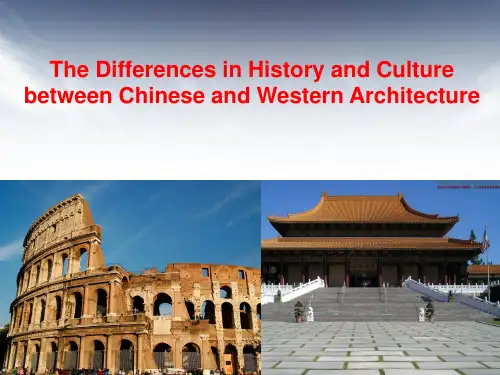

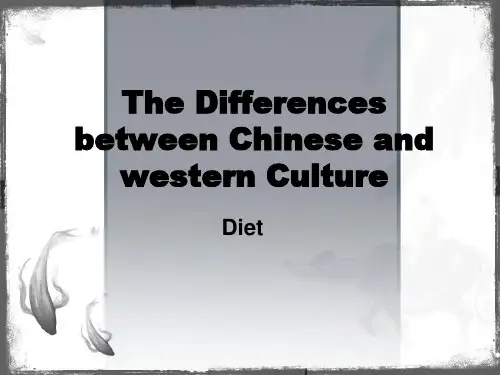
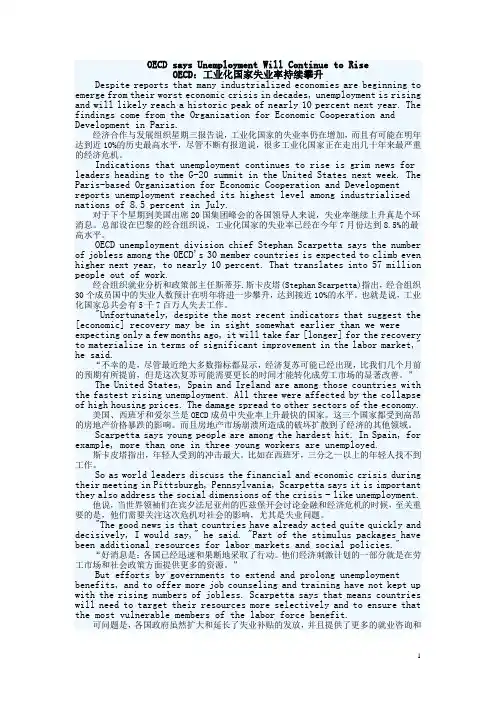
OECD says Unemployment Will Continue to RiseOECD:工业化国家失业率持续攀升Despite reports that many industrialized economies are beginning to emerge from their worst economic crisis in decades, unemployment is rising and will likely reach a historic peak of nearly 10 percent next year. The findings come from the Organization for Economic Cooperation and Development in Paris.经济合作与发展组织星期三报告说,工业化国家的失业率仍在增加,而且有可能在明年达到近10%的历史最高水平,尽管不断有报道说,很多工业化国家正在走出几十年来最严重的经济危机。
Indications that unemployment continues to rise is grim news for leaders heading to the G-20 summit in the United States next week. The Paris-based Organization for Economic Cooperation and Development reports unemployment reached its highest level among industrialized nations of 8.5 percent in July.对于下个星期到美国出席20国集团峰会的各国领导人来说,失业率继续上升真是个坏消息。
总部设在巴黎的经合组织说,工业化国家的失业率已经在今年7月份达到8.5%的最高水平。
中西方文化差异英文版Culture is a very broad term that includes many things such as habits, behaviors, languages, and more. Now, I would like to introduce some differences between Chinese and Western culture. At first, let"s talk about marriage customs. In China, the bride and groom would wear red clothes because we believe that red represents happiness and luck. And the wedding ceremony would be hosted at the bride"s house. However, in America, the bride always wears a white wedding gown and the wedding ceremony is usually held in a church.Another difference is the way of describing food. In China, people often use words like "color," "smell," "taste," and "sharp" to describe food. For example, if we say "this food is delicious," we mean it tastes good and is not boring. However, in the West, people usually pay attention to calories, vitamins, and proteins.Furthermore, the way of treating children also differs between China and the West. In China, parents often show love by spanking or hitting their children, but in the West, it is considered disrespectful and illegal.Moreover, traditional Chinese medical system regards symptoms as the key to diagnose and treat diseases, while inthe West, people usually consult doctors or pharmacists to diagnose their diseases.In conclusion, there are many differences between Chinese and Western culture, such as marriage customs, food description, child-rearing practices, and medical systems. These differences reflect the diversity and richness of human cultures and should be 尊重和欣赏。
餐饮产品由于地域特征、气侯环境、风俗习惯等因素的影响,会出现在原料、口味、烹调方法、饮食习惯上的不同程度的差异。
正是因为这些差异,餐饮产品具有了强烈的地域性。
中西文化之间的差异造就了中西饮食文化的差异,而这种差异来自中西方不同的思维方式和处世哲学。
中国人注重“天人合一”,西方人注重“以人为本”。
这里简要从下面三个方面谈谈中西方饮食文化的差异。
The dining product as a result of factor and so on region characteristic, climatic environment, manners and customs influences, will appear in raw material, the taste, the cooking method, the food habit varying degree difference. Was precisely because of these differences, the dining product had the intense localization. Between China and the West culture's difference has accomplished China and the West diet culture difference, but this kind of difference and gets along with people the philosophy from the West different thinking mode. The Chinese pays great attention “the beauty to uni te”, the westerner pays great attention “humanist”. here chats the Western diet culture difference briefly from the following three aspects. 第二种翻译:Food products due to geographical features, climate, customs, and other factors, will appear in the raw materials, food, cooking methods, dietary habits on the varying degrees of difference. It is precisely because of these differences in food products with a strong regional. The difference between Chinese and Western cultures to create a diet of Chinese and Western cultural differences, and differences from the West in a different way of thinking and philosophy of life. Chinese people pay attention to the "Heaven and Man," in the West focus on "people-oriented."From here, a brief talk about the following three areas in the Western diet and cultural differences.一、两种不同的饮食观念对比注重“味”的中国饮食,西方是一种理性饮食观念。